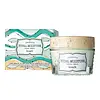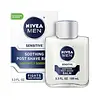What's inside
What's inside
 Key Ingredients
Key Ingredients

 Benefits
Benefits

 Concerns
Concerns

 Ingredients Side-by-side
Ingredients Side-by-side

Water
Skin ConditioningDicaprylyl Carbonate
EmollientHydrogenated Lanolin
EmollientSqualane
EmollientGlycerin
HumectantMethyl Trimethicone
Skin ConditioningGlyceryl Stearate
EmollientStearyl Alcohol
EmollientPEG-8
HumectantPentylene Glycol
Skin ConditioningCaprylic/Capric/Succinic Triglyceride
EmollientCeteth-20
CleansingEthylhexyl Palmitate
EmollientDimethicone
EmollientBetaine
HumectantDecyloxazolidinone
AntimicrobialPhenoxyethanol
PreservativeCetyl Alcohol
EmollientPalmitic Acid
EmollientStearic Acid
CleansingParfum
MaskingSteareth-25
CleansingMangifera Indica Seed Butter
Skin ConditioningSteareth-21
CleansingTetrasodium EDTA
Tocopheryl Acetate
AntioxidantCarbomer
Emulsion StabilisingXylitylglucoside
HumectantSorbitol
HumectantLinalool
PerfumingAnhydroxylitol
HumectantSodium Hydroxide
BufferingAlgin
MaskingXylitol
HumectantHexyl Cinnamal
PerfumingLimonene
PerfumingPolyvinyl Alcohol
Cellulose Gum
Emulsion StabilisingTocopherol
AntioxidantBHT
AntioxidantWater, Dicaprylyl Carbonate, Hydrogenated Lanolin, Squalane, Glycerin, Methyl Trimethicone, Glyceryl Stearate, Stearyl Alcohol, PEG-8, Pentylene Glycol, Caprylic/Capric/Succinic Triglyceride, Ceteth-20, Ethylhexyl Palmitate, Dimethicone, Betaine, Decyloxazolidinone, Phenoxyethanol, Cetyl Alcohol, Palmitic Acid, Stearic Acid, Parfum, Steareth-25, Mangifera Indica Seed Butter, Steareth-21, Tetrasodium EDTA, Tocopheryl Acetate, Carbomer, Xylitylglucoside, Sorbitol, Linalool, Anhydroxylitol, Sodium Hydroxide, Algin, Xylitol, Hexyl Cinnamal, Limonene, Polyvinyl Alcohol, Cellulose Gum, Tocopherol, BHT
Water
Skin ConditioningCyclomethicone
EmollientGlyceryl Lanolate
EmollientPanthenol
Skin ConditioningPropylene Glycol
HumectantIsopropyl Palmitate
EmollientTocopheryl Acetate
AntioxidantBisabolol
MaskingAllantoin
Skin ConditioningHamamelis Virginiana Water
AstringentGlycine Soja Hull
AbrasiveCalendula Officinalis Flower
Skin ConditioningCitric Acid
BufferingTriceteareth-4 Phosphate
EmulsifyingSodium Carbomer
Emulsion StabilisingPhenoxyethanol
PreservativeEthylparaben
PreservativeMethylparaben
PreservativePropylparaben
PreservativeButylparaben
MaskingParfum
MaskingWater, Cyclomethicone, Glyceryl Lanolate, Panthenol, Propylene Glycol, Isopropyl Palmitate, Tocopheryl Acetate, Bisabolol, Allantoin, Hamamelis Virginiana Water, Glycine Soja Hull, Calendula Officinalis Flower, Citric Acid, Triceteareth-4 Phosphate, Sodium Carbomer, Phenoxyethanol, Ethylparaben, Methylparaben, Propylparaben, Butylparaben, Parfum
Ingredients Explained
These ingredients are found in both products.
Ingredients higher up in an ingredient list are typically present in a larger amount.
Parfum is a catch-all term for an ingredient or more that is used to give a scent to products.
Also called "fragrance", this ingredient can be a blend of hundreds of chemicals or plant oils. This means every product with "fragrance" or "parfum" in the ingredients list is a different mixture.
For instance, Habanolide is a proprietary trade name for a specific aroma chemical. When used as a fragrance ingredient in cosmetics, most aroma chemicals fall under the broad labeling category of “FRAGRANCE” or “PARFUM” according to EU and US regulations.
The term 'parfum' or 'fragrance' is not regulated in many countries. In many cases, it is up to the brand to define this term.
For instance, many brands choose to label themselves as "fragrance-free" because they are not using synthetic fragrances. However, their products may still contain ingredients such as essential oils that are considered a fragrance by INCI standards.
One example is Calendula flower extract. Calendula is an essential oil that still imparts a scent or 'fragrance'.
Depending on the blend, the ingredients in the mixture can cause allergies and sensitivities on the skin. Some ingredients that are known EU allergens include linalool and citronellol.
Parfum can also be used to mask or cover an unpleasant scent.
The bottom line is: not all fragrances/parfum/ingredients are created equally. If you are worried about fragrances, we recommend taking a closer look at an ingredient. And of course, we always recommend speaking with a professional.
Learn more about ParfumPhenoxyethanol is a preservative that has germicide, antimicrobial, and aromatic properties. Studies show that phenoxyethanol can prevent microbial growth. By itself, it has a scent that is similar to that of a rose.
It's often used in formulations along with Caprylyl Glycol to preserve the shelf life of products.
Tocopheryl Acetate is AKA Vitamin E. It is an antioxidant and protects your skin from free radicals. Free radicals damage the skin by breaking down collagen.
One study found using Tocopheryl Acetate with Vitamin C decreased the number of sunburned cells.
Tocopheryl Acetate is commonly found in both skincare and dietary supplements.
Learn more about Tocopheryl AcetateWater. It's the most common cosmetic ingredient of all. You'll usually see it at the top of ingredient lists, meaning that it makes up the largest part of the product.
So why is it so popular? Water most often acts as a solvent - this means that it helps dissolve other ingredients into the formulation.
You'll also recognize water as that liquid we all need to stay alive. If you see this, drink a glass of water. Stay hydrated!
Learn more about Water